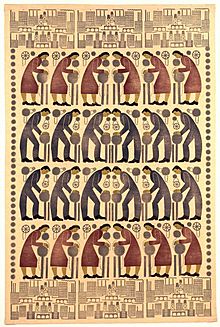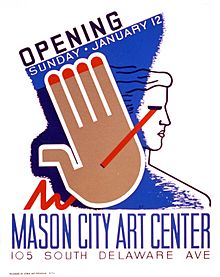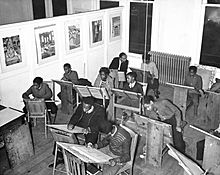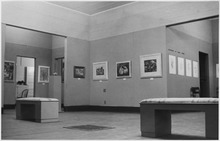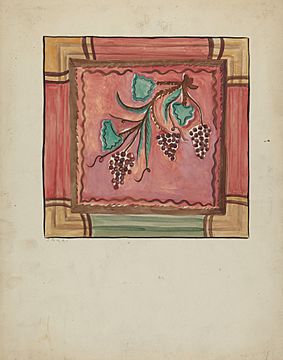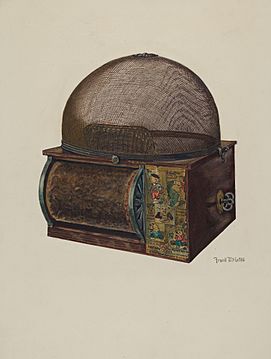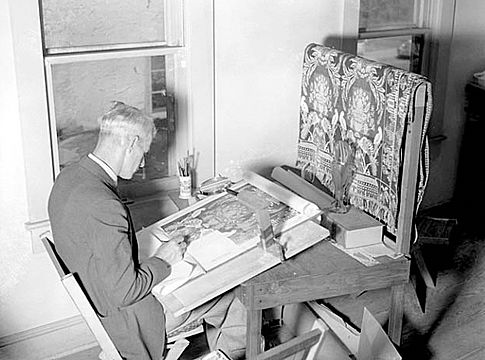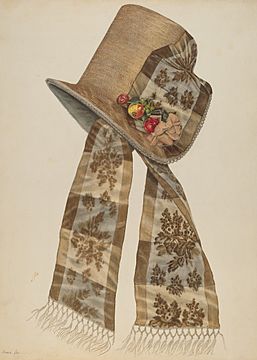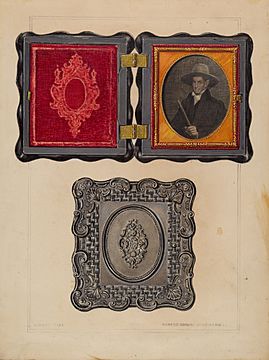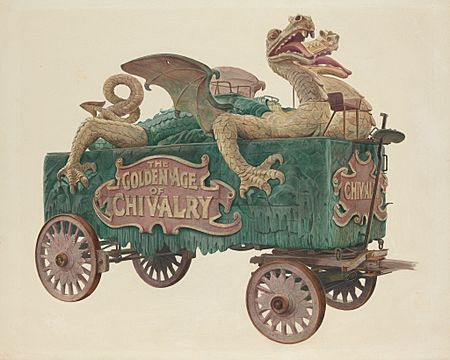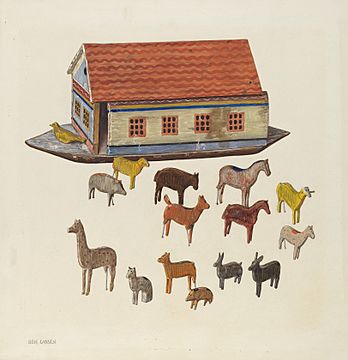Federal Art Project facts for kids
Eagle and palette design regarded as the logo of the Federal Art Project
|
|
| Agency overview | |
|---|---|
| Formed | 29 August 1935 |
| Dissolved | 1943 |
| Jurisdiction | United States |
| Headquarters | Washington, D.C. |
| Agency executive |
|
| Parent department | Works Progress Administration (WPA) |
The Federal Art Project (1935–1943) was a special program in the United States. It was part of the New Deal, a series of programs created by the government to help the country recover from the Great Depression. The main goal of the Federal Art Project was to give jobs to artists and craftspeople.
Under the leadership of Holger Cahill, this project was one of the biggest art programs of its time. It wasn't just about creating art for fun. It was a way to help people earn money by making murals, paintings, sculptures, posters, and other artworks. The project also opened over 100 community art centers across the country. It helped about 10,000 artists and workers during a very tough time for the United States.
Contents
What Was the Federal Art Project?
The Federal Art Project was a part of a larger government program called the Works Progress Administration (WPA). The WPA aimed to provide jobs for many people who were out of work during the Great Depression. The Federal Art Project specifically focused on helping artists.
It started on August 29, 1935, and ended on June 30, 1943. Artists were hired to create all kinds of art, including:
- Murals (large paintings on walls)
- Easel paintings (paintings on canvases)
- Sculptures
- Graphic art and posters
- Photographs
- Designs for theater sets
- Arts and crafts
The project's main goals were simple: give jobs to artists and provide art for public buildings like schools and hospitals. Artists were paid about $23.60 a week. The places that received the art, like schools, only had to pay for the materials used.
The work was divided into three main areas:
- Art production: This was where artists created new artworks.
- Art instruction: Artists taught art classes to the public.
- Art research: This group studied and documented American design.
One very successful part of the project was the Milwaukee Handicraft Project. It began in 1935 and employed many people, including those who were older or had disabilities. This project taught workers skills like bookbinding and block printing. They made handmade art books, children's books, toys, dolls, and even furniture. These items were then used by schools and hospitals, helping many communities.
Holger Cahill was the national director of the Federal Art Project. Other important leaders helped manage the project in different regions of the country.
Famous Artists Who Participated
About 10,000 artists worked for the Federal Art Project. Many of them became very famous later on. The project supported artists like Jackson Pollock before their work became well-known. It helped them continue creating art when it was hard to sell their work.
Here are some of the notable artists who were part of the project:
- William Abbenseth
- Berenice Abbott
- Ida York Abelman
- Gertrude Abercrombie
- Benjamin Abramowitz
- Abe Ajay
- Ivan Albright
- Maxine Albro
- Charles Alston
- Harold Ambellan
- Luis Arenal
- Bruce Ariss
- Victor Arnautoff
- Sheva Ausubel
- Jozef Bakos
- Henry Bannarn
- Belle Baranceanu
- Patrociño Barela
- Will Barnet
- Richmond Barthé
- Herbert Bayer
- William Baziotes
- Lester Beall
- Harrison Begay
- Daisy Maud Bellis
- Rainey Bennett
- Aaron Berkman
- Leon Bibel
- Robert Blackburn
- Arnold Blanch
- Lucile Blanch
- Lucienne Bloch
- Aaron Bohrod
- Ilya Bolotowsky
- Adele Brandeis
- Louise Brann
- Edgar Britton
- Manuel Bromberg
- James Brooks
- Selma Burke
- Letterio Calapai
- Samuel Cashwan
- Giorgio Cavallon
- Daniel Celentano
- Dane Chanase
- Fay Chong
- Claude Clark
- Max Arthur Cohn
- Eldzier Cortor
- Arthur Covey
- Alfred D. Crimi
- Francis Criss
- Allan Crite
- Robert Cronbach
- John Steuart Curry
- Philip Campbell Curtis
- James Daugherty
- Stuart Davis
- Adolf Dehn
- Willem de Kooning
- Burgoyne Diller
- Isami Doi
- Mabel Dwight
- Ruth Egri
- Fritz Eichenberg
- Jacob Elshin
- George Pearse Ennis
- Angna Enters
- Philip Evergood
- Louis Ferstadt
- Alexander Finta
- Joseph Fleck
- Seymour Fogel
- Lily Furedi
- Todros Geller
- Aaron Gelman
- Eugenie Gershoy
- Enrico Glicenstein
- Vincent Glinsky
- Bertram Goodman
- Arshile Gorky
- Harry Gottlieb
- Blanche Grambs
- Morris Graves
- Balcomb Greene
- Marion Greenwood
- Waylande Gregory
- Philip Guston
- Irving Guyer
- Abraham Harriton
- Marsden Hartley
- Knute Heldner
- August Henkel
- Ralf Henricksen
- Magnus Colcord Heurlin
- Hilaire Hiler
- Louis Hirshman
- Donal Hord
- Axel Horn
- Milton Horn
- Allan Houser
- Eitaro Ishigaki
- Edwin Boyd Johnson
- Sargent Claude Johnson
- Tom Loftin Johnson
- William H. Johnson
- Leonard D. Jungwirth
- Reuben Kadish
- Sheffield Kagy
- Jacob Kainen
- David Karfunkle
- Leon Kelly
- Paul Kelpe
- Troy Kinney
- Georgina Klitgaard
- Gene Kloss
- Karl Knaths
- Edwin B. Knutesen
- Lee Krasner
- Kalman Kubinyi
- Yasuo Kuniyoshi
- Jacob Lawrence
- Edward Laning
- Michael Lantz
- Blanche Lazzell
- Tom Lea
- Lawrence Lebduska
- Joseph LeBoit
- William Robinson Leigh
- Julian E. Levi
- Jack Levine
- Monty Lewis
- Elba Lightfoot
- Abraham Lishinsky
- Michael Loew
- Thomas Gaetano LoMedico
- Louis Lozowick
- Nan Lurie
- Guy Maccoy
- Stanton Macdonald-Wright
- George McNeil
- Moissaye Marans
- David Margolis
- Kyra Markham
- Jack Markow
- Mercedes Matter
- Jan Matulka
- Dina Melicov
- Hugh Mesibov
- Katherine Milhous
- Jo Mora
- Helmuth Naumer
- Louise Nevelson
- James Michael Newell
- Spencer Baird Nichols
- Elizabeth Olds
- John Opper
- William C. Palmer
- Phillip Pavia
- Irene Rice Pereira
- Jackson Pollock
- George Post
- Gregorio Prestopino
- Mac Raboy
- Anton Refregier
- Ad Reinhardt
- Misha Reznikoff
- Mischa Richter
- Diego Rivera
- José de Rivera
- Emanuel Glicen Romano
- Mark Rothko
- Alexander Rummler
- Augusta Savage
- Concetta Scaravaglione
- Louis Schanker
- Edwin Scheier
- Mary Scheier
- Carl Schmitt
- William S. Schwartz
- Georgette Seabrooke
- Ben Shahn
- William Howard Shuster
- Mitchell Siporin
- John French Sloan
- Joseph Solman
- William Sommer
- Isaac Soyer
- Moses Soyer
- Raphael Soyer
- Ralph Stackpole
- Cesare Stea
- Walter Steinhart
- Joseph Stella
- Harry Sternberg
- Sakari Suzuki
- Albert Swinden
- Rufino Tamayo
- Elizabeth Terrell
- Lenore Thomas
- Dox Thrash
- Mark Tobey
- Harry Everett Townsend
- Edward Buk Ulreich
- Charles Umlauf
- Jacques Van Aalten
- Stuyvesant Van Veen
- Herman Volz
- Mark Voris
- John Augustus Walker
- Andrew Winter
- Jean Xceron
- Edgar Yaeger
- Bernard Zakheim
- Karl Zerbe
Community Art Centers
The Federal Art Project opened many community art centers across the country. The very first one opened in December 1936 in Raleigh, North Carolina. These centers were important places where people could see art, learn about art, and even take art classes.
The centers were open to everyone. They helped bring art to communities that might not have had art museums or galleries before. They also provided a place for artists to work and teach.
Index of American Design
The Index of American Design was a special part of the Federal Art Project. Its job was to create a visual record of American crafts and decorative arts. These were items made in the United States from the early colonial period up to 1900.
Artists working for the Index made almost 18,000 detailed watercolor drawings. They carefully drew objects like furniture, silver, glass, textiles, and even old toys. The goal was to document these items before they were lost or forgotten.
Holger Cahill, the project director, said that the Index helped show the amazing skills of American craftspeople. It brought together thousands of examples from different parts of the country. This helped people understand the history of American hand-made items.
The Index was not just about looking back. It also aimed to help modern artists and designers. By studying old American designs, they could get ideas for new creations. This collection of drawings became a valuable resource for museums, libraries, and schools.
The Index of American Design operated in 34 states and Washington, D.C., from 1935 to 1942. It employed about 300 artists. One artist, Magnus S. Fossum, lost his left hand in an accident. But he still created beautiful watercolor drawings for the Index, using special tools to be very precise.
WPA Art Recovery Project
The Federal Art Project created hundreds of thousands of artworks. Many of these pieces were portable, meaning they could be moved. Over the years, some of these artworks were lost, forgotten, or given away without permission.
The General Services Administration (GSA) is the government agency responsible for these artworks. They keep a list of the art and work with the FBI and art experts to find and get back WPA art. In 2010, the GSA made a short film about their efforts to recover this art.
By 2014, the GSA estimated that only about 20,000 of the portable artworks had been found. In 2015, investigators found 122 Federal Art Project paintings in California libraries. They had been stored there and forgotten for many years.
Images for kids



